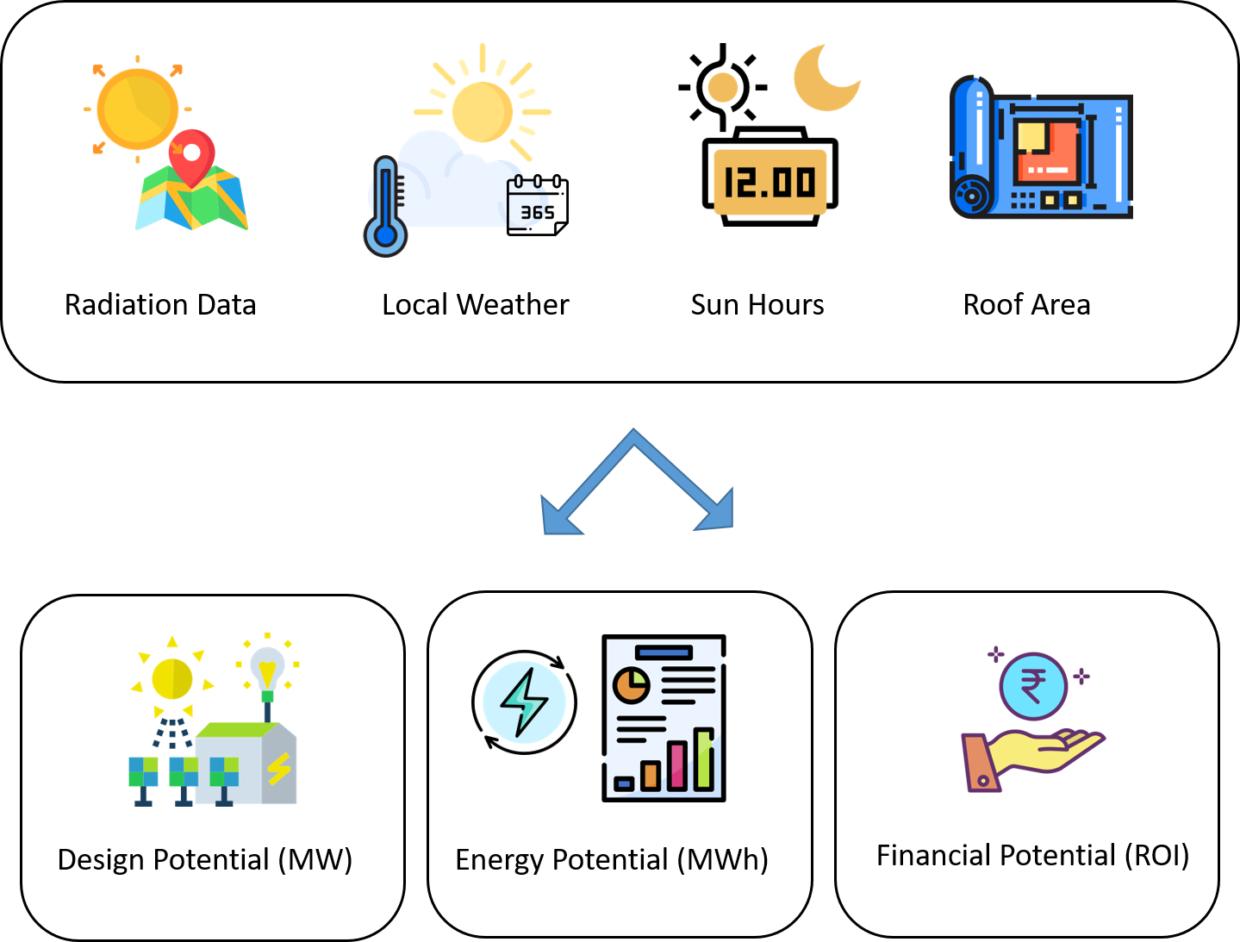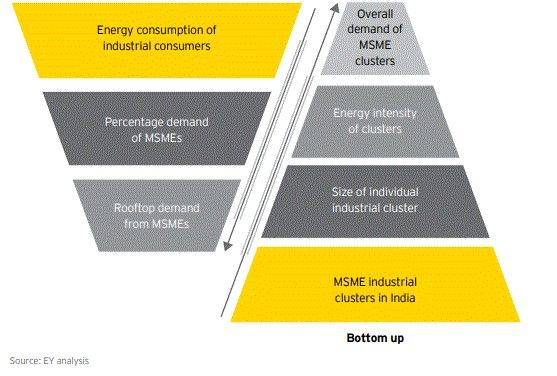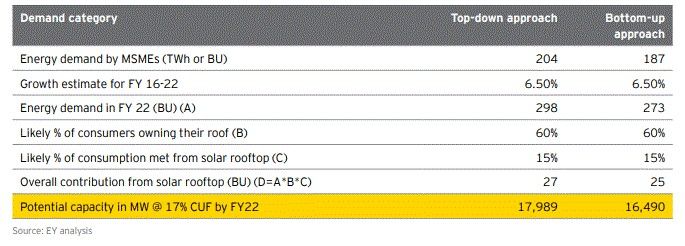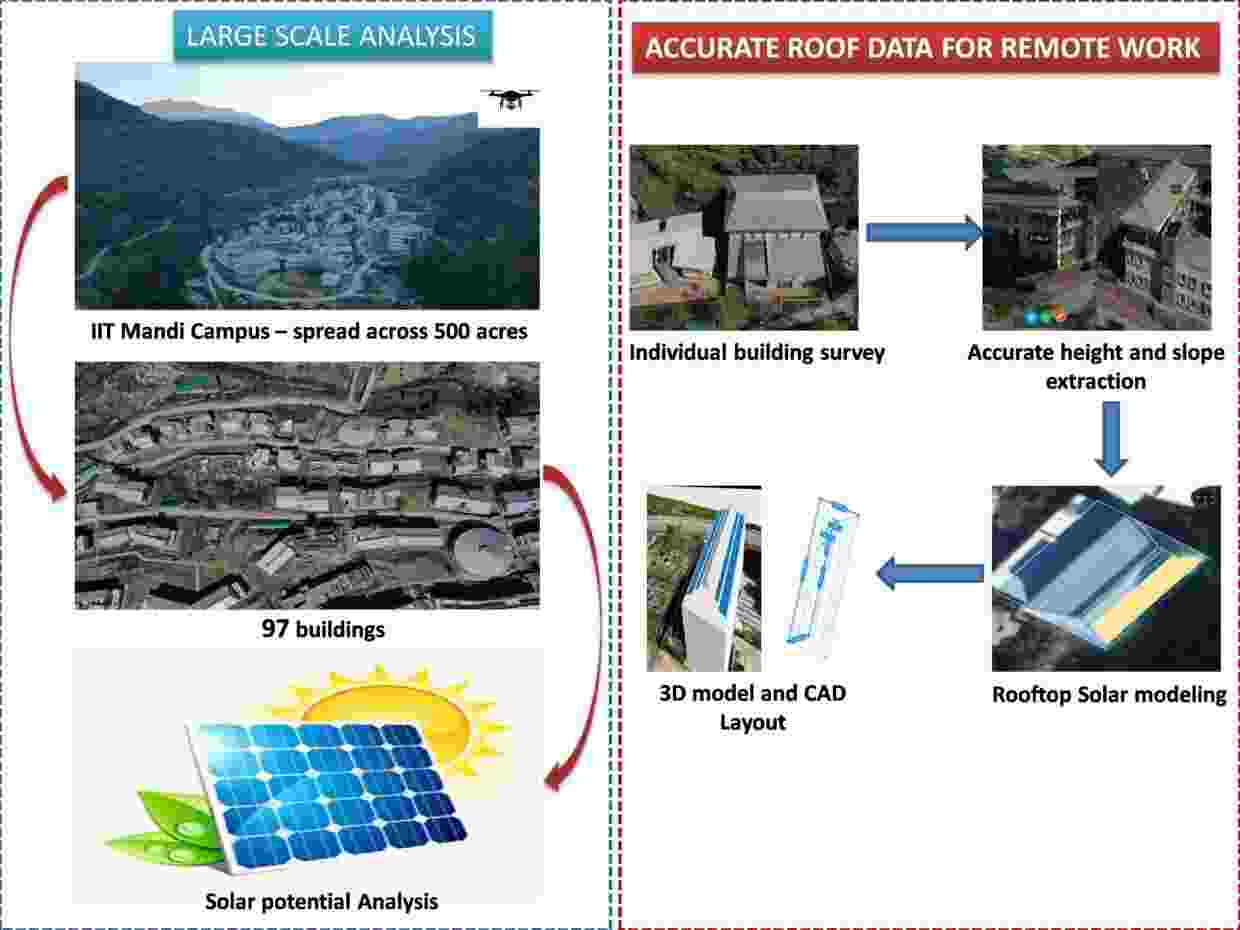Large Scale Solar Potential Analysis: Indian Overview

This article is Part 2 in a series of articles about solar potential estimation. In this article, we will be mainly discussing different types of solar potential estimation and various efforts made by India in large-scale solar potential analysis.
In the previous part, we have discussed in detail the term solar potential and mostly used tools for solar potential estimation.
Introduction
With rapid climate change and continual air quality deterioration recognized as global issues, every country is now trying to reduce its greenhouse gas emissions. Rapid urbanization has contributed to the over-consumption of energy, increased air emissions, and degradation of the environment.
Looking into the Indian context, a major chunk of its energy needs is met through non-renewable sources like coal, lignite, diesel, etc. The use of non-renewable sources also poses the question of sustainability. In this regard, one of the most efficient solutions to these challenges is the transition from fossil fuel to renewable energy sources. Solar PV cells are considered one of the cleanest sources of energy and are regarded as the best alternative to fossil fuels.
Importance of Solar Potential Estimation
As per recent data, India ranks fourth in the world after the US, China, and Russia in electricity generation using renewable energy sources (RES). Its share of renewable energy rose from 13.17 percent in 2015 to 23.3 percent in 2020. The current solar power generation in the country is 34,046 MW which accounts for 9.24% of the total energy demand. The Government aims to achieve 100,000 MW of solar energy potential by the year 2022. To bridge this substantial gap between the aspired and the already installed capacity, an extensive solar potential assessment and installation is required.
The detailed and precise estimation of solar energy is a major requirement for solar applications on building rooftops. These estimations help in sustainable development, energy policy-making, and renewable energy consumption. It is also crucial to reveal the potential amount of electricity that could be produced by deploying PV systems on building rooftops and whether it will suffice the energy demand or not.
Types of Solar Potential Estimation

- Theoretical Potential: The theoretical potential identifies the physical upper limit of the energy available from a certain source. For solar energy, for example, this would be the total solar radiation falling on a particular surface. This potential does therefore not take account of any restrictions on utilization, nor is the efficiency of the conversion technologies considered.
- Technical Potential: Technical potential estimates the capacity of an RE technology (solar PV, wind, etc.) available for development after accounting for topographic limitations, land-use constraints, and system performance. The technical potential assessment enables the initial identification of study areas that are technically capable of supporting high-quality RE resource development.
- Economic Potential: This potential identifies the proportion of the technological potential that can be utilized economically, based on economic boundary conditions at a certain time. These boundary conditions can be technology costs, applicable incentives, and electricity prices, among others.
- Market potential: Estimated potential aftermarket considerations such as competition with other energy sources, policy implementation, and impacts, regulatory limits, investor response
- Sustainable Potential: This potential of an energy source covers all aspects of sustainability, which usually requires careful consideration and evaluation of different ecological and socio-economic aspects
Overview of India’s Solar Potential
India has a great potential for solar power and it is estimated to be many times the current energy requirement which is about 5000 trillion kWh per year. The solar radiation incident over India is equal to 4–8 kWh per square meter per day with annual radiation ranging from 1200–2300 kWh per square meter. It has an average of 250–300 clear sunny days and 2300–3200 hours of sunshine per year. India’s electricity needs can be met on a total land area of 3000 km which is equal to 0.1% of total land in the country.
Various efforts made by India for Large Scale Potential Analysis
There are various studies done and ongoing research work for estimating the rooftop solar potential in different Indian cities. Mostly for estimating the solar potential on a large scale, geospatial tools are adopted wherein available rooftop area is detected from satellite images. From the estimated building rooftop area/building footprint, the solar potential is calculated using different open tools and algorithms.
Some of the prominent studies conducted for large-scale potential estimation are listed below –
Rooftop Revolution: Unleashing Delhi’s Solar Potential (A study by BRIDGE TO INDIA)
With Delhi’s electricity demand rising every year by an average of 6% and its peak demand breaching the 5000 MW mark, it poses a fundamental question of how to ensure a consistent electricity supply. The best possible answer for this could be massive-scale rooftop solar installation reducing the burden on DISCOMs at the same time bringing down the pollution levels in the city.
Bridge to India in their report proposed that theoretically, the total land area on which Delhi is built could support 123 GW of solar PV of which 2 GW of solar capacity could be achieved by 2020. Therefore, 2 GW requires only 1.6% of the city’s land.
They arrived at their 2 GW target for Delhi by combining three perspectives. Firstly they looked at the available rooftop space to reach a geographic potential. Then, they looked at the economic viability of solar for different tariff groups and system sizes. Lastly, they assessed how much grid-connected solar power the grid could handle.
Assessment of roof-top solar energy potential in proposed Smart Cities of India
This study was conducted by Shashikant Sharma, Gaurav Jain, Shweta Mishra, and Bimal Bhattacharya (Space Applications Centre, Jodhpur Tekra, Ahmedabad). A total of 98 cities have been identified under the Smart Cities Mission to further their infrastructure development goals with the aid of information and communication technology. These proposed Indian Smart Cities have been encouraged to meet 10‐15% of respective energy demand from renewable energy resources, wherein solar energy can contribute significantly.
This study comprises estimating the rooftop photovoltaic (PV) potential of these 98 cities. The built‐up area of these study cities is obtained from various spatial databases from legacy projects, subsequently updated from LISS‐3 images acquired by Indian Remote Sensing satellites. The global (total) horizontal insolation, combining direct as well diffuse components of incident solar energy, is obtained from KALPANA‐1 VHRR data for past years. The monthly as well as annual solar insolation over each study city was computed and total roof‐top solar PV potential was thus estimated. The study estimates 10.02 GW of grid‐connected roof‐top PV potential with 103.51 TWh of energy annually in the proposed 98 smart cities of India.
Identifying barriers to rooftop solar uptake in MSMEs and development of a mitigating financial framework by EY
In the section “Rooftop Solar potential in MSME sector” presented in this report, two different approach has been adopted.

- Top-down approach – The top-down approach involves estimating the MSME energy consumption by firstly looking at the total energy consumption of industrial consumers in the country, estimating the percentage demand of MSMEs out of the total industrial demand and finally arriving at the rooftop potential for MSMEs, based on the assumptions related to MSMEs meeting a portion of their energy demands through rooftop solar
- Bottom-up approach – The bottom-up approach involves looking at the energy requirements of the various MSME clusters in India by estimating the average size of each industrial cluster, the energy profile (energy intensity) of each cluster, and the number of clusters, which again gives us the rooftop potential in MSMEs.
Following the above-mentioned approaches, the calculations have been shown in the below table

It has been observed that both approaches converge to a rooftop solar potential figure of ~16.5 GW to ~18 GW in the MSME segment. This is a huge potential, which if properly tapped, can go a long way towards meeting half of the rooftop solar target of 40 GW by 2022.
Report of the expert group on 175 GW Renewable energy by 2022 by NITI Aayog
This report is mainly focused on, how to utilize public finance to achieve 175 GW RE by 2022. The report also highlights that India’s major advantage today and going forward is its vast and largely untapped renewable energy (RE) potential. Recent estimates show that India’s solar potential is greater than 750 GW and its announced wind potential is 302 GW (actually could be higher than 1000 GW). India Energy Security Scenarios 2047 show a possibility of achieving a high of 479 GW of solar PV by 2047. The potential of biomass and small hydro is also significant. Thus, renewable energy has the potential to anchor the development of India’s electricity sector.
Solar Energy Generation Potential Estimation in India and Gujarat, Andhra, Telangana States
This research study has been carried out by Tirumalachetty, Harinarayana & Ketharaju, and Jaya Kashyap. (2014). Solar Energy Generation Potential Estimation in India and Gujarat, Andhra, Telangana States. Smart Grid and Renewable Energy. 05. 275-289. 10.4236/sgre.2014.511025.
Through this research, it is shown that solar energy generation at a given location does not depend only on solar radiation. Instead, energy production is affected by numerous other factors such as air temperature, wind speed, and other factors, such as weather and topographic conditions. In this study, the locations with high and low solar energy generation potential in India have been identified through systematic analysis by computing the solar energy parameters at every grid point (1˚×1˚× 1˚). The work has been extended with a more detailed study for Gujarat, Andhra Pradesh, and the newly formed Telangana states. The data points considered for the states are 0.25˚×25˚× 0.25˚ having resulted in adding more locations.
The findings suggest that India’s overall annual energy production ranges from 510,000 KWH to 800,000 KWH per acre of land. The least energy generation location pertains to the eastern parts of Arunachal Pradesh and the eastern part of Assam and the highest annual solar energy generation has been identified in the eastern parts of Jammu & Kashmir and the eastern part of Uttarakhand.
How ARKA 360 design studio performs large scale potential analysis
TSL is a SAAS-based solar design software company mostly involved in the rooftop domains and providing design engineers with one-stop solutions for all their design needs. We also provide design consultancy services to the solar EPC’s.
Recently we have conducted a large-scale solar potential analysis for the entire IIT Mandi campus comprising a total of 96 buildings, spread over 538 acres and grouped into 3 clusters using our TSL Design Studio software. The entire work took less than a week to complete and our workflow is depicted below:

For accurate potential estimation, we have used drone images, and further modeling has been done using our TSL Design Studio. Have a look at the complete case study
The use of the TSL design studio ensured higher accuracy in solar potential estimation since, each rooftop was individually modeled taking care of the key parameters such as shadow analysis, roof’s orientation, tilt, etc.
Thus we observe that the commonly adopted tool for large-scale solar potential analysis is geospatial modeling wherein, building rooftops or footprints are extracted from satellite images and using some machine learning algorithms. Stil,l there are several ongoing researchworksk in this domain to improve the accuracy of building edge detection and its potential estimation.
In Part 3 of this series about solar potential estimation, we will discuss in detail several automated tools and techniques forlarge-scalee potential estimation.

